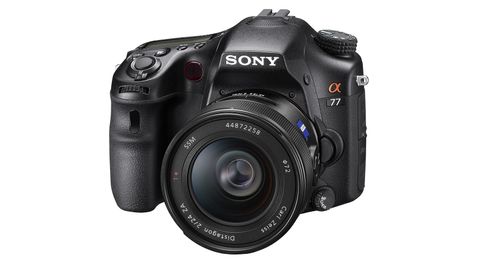Why you can trust TechRadar

Sporting a rugged plastic-clad outer shell wrapped around magnesium alloy chassis and with seals around important controls and dials to help guard against water and dust ingress, the Sony Alpha A77 looks and feels every inch the semi-pro camera.
In terms of design and build quality, it's on a par with rival cameras such as the Canon EOS 7D, Nikon D300S and Sony A850.
The Sony Alpha A77 features a generous, ergonomically-shaped front grip, with neatly carved out grooves to comfortably accommodate your digits. A large rubberised area on the back panel also curves outward slightly to give your thumb somewhere to rest too, helping you to keep a firm grasp on the camera.
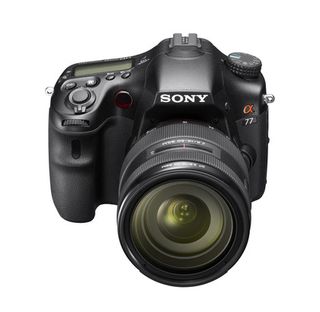
Although at 732g, fully-loaded, the Sony Alpha A77 isn't what we'd call 'lightweight', it does weigh in at roughly 100g less than main rivals, without feeling any 'cheaper' or less robust as a result.
In terms of design, you'd be hard pushed to identify the Sony Alpha A77 as being any different to its DSLR counterparts. Roughly the same size and overall shape as a traditional SLR-based camera, the Sony Alpha A77 features all of the usual controls and dials that you'd expect to find on a camera of this calibre, benefitting from a more organic-looking design than its decidedly-utilitarian-looking predecessor.
The front panel hosts only a few components, namely a small focus-mode dial in the bottom right-hand corner, below the lens mount, along with a bright AF-assist lamp above and to the left (looking at the camera face-on). There's an IR receiver for the optional remote that you can purchase separately, and a depth-of-field preview button below and to the left.
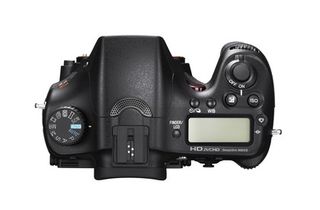
The undulating top panel houses a well-stocked mode dial to the left of the camera's hotshoe. Chunky and clad in textured rubber, the dial is tactile and easy to grip and operate.
Exposure modes are clearly marked on top, with options comprising Auto, Auto+ (which analyses the frame and selects the appropriate settings to suit), eight scene modes, Sweep Panorama, 3D mode, high-speed Burst and HD movie modes, as well as Program, Aperture Priority, Shutter Priority and Manual modes.
Finally, there's a user-customisable Memory Recall slot, which enables you to store your own settings 'recipes' for up to three different types of photographic situations.
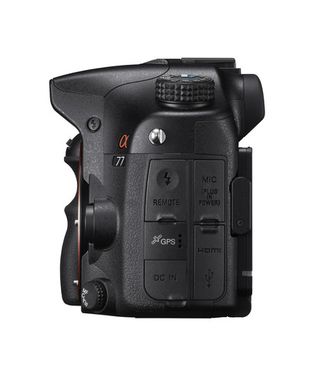
The Sony Alpha A77's business-like built-in pop-up flash sits flush to the top of the viewfinder hump, just forward of the camera's stereo microphones and rapidly springing into life to sit high above the lens as soon as it's activated.
To the right, there's a useful secondary LCD display for keeping tabs on your settings at-a-glance, along with a button for toggling between the EVF and LCD screen, plus dedicated controls providing access to the camera's drive, white balance, exposure compensation and ISO settings.
The responsive shutter release is encircled by a power switch, while a small button adjacent to the LCD enables you to illuminate it in dim lighting conditions.
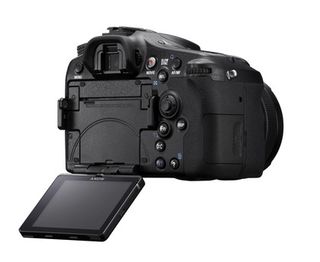
The back panel is littered with an array of further controls, including a silver one-touch movie button that gives you direct access to the Sony Alpha A77's HD movie mode.
Further dedicated buttons include an AF/MF control that also zooms into playback images for fast focus-checking, in addition to AEL, display, function, playback, Help/delete and Smart Teleconverter controls. Some of these buttons are customisable, should you wish to use them to access alternative settings: a handy feature that brings the Sony Alpha A77's interface into line with its similarly-versatile rivals.
Speaking of versatility, we come to the Sony Alpha A77's articulated LCD. The design is somewhat a novelty, with the screen first tilting forwards and down, then it can be swivelled left or right, as well as being pulled away from the body on a hinged arm-like mechanism that enables it to perform further acrobatics.
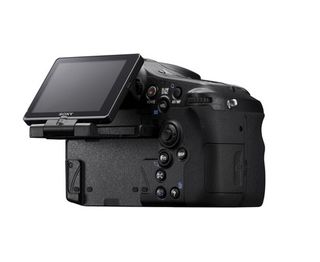
The screen itself is very clear, crisp and bright, with an effective anti-reflective coating and wide viewing angle, making it incredibly usable under all manner of lighting conditions and at a wide range of odd angles.
If you are faced with a situation where using the LCD is tricky or undesirable, the EVF provides a perfectly viable alternative. It's cheerfully clear, detailed and bright, providing 100% coverage of the frame. An added bonus is the option to display an array of shooting information and/or a digital spirit level, live histogram and navigate the menu system through the EVF - tricks that no optical viewfinder can perform.
There are a few drawbacks to be noted, however: although the refresh rate is good enough in most situations, there is some evidence of ghosting when the ambient light changes in intensity, as well as when panning quickly, although these are minor issues.

We also found the lag between raising the EVF to your eye and it activating a little frustrating at times. You can set the EVF to remain on permanently, but this disables the screen, which isn't ideal either.
The gap between the LCD turning off and the EVF on is minimal, but it's still there, and as such highlights its limitations in comparison to an optical viewfinder. Nonetheless, it's still streets ahead of any other EVF on the market. The notion of using an EVF might not be everyone's preference, but we urge you to visit a store and try this one out: minor niggles aside, you're unlikely to be disappointed.
The main menu system sticks with the tried-and-tested Sony format, with white text on black and orange highlighting the option you've selected. Options are split across tabs for easier navigation and - although there is quite an extensive range of options and settings to explore - the menus remain simple to navigate.

Intel unveils flurry of new Arc GPUs — however serious graphics users will have to wait for more powerful models, as these focus on a completely different and more lucrative market

We just got another hint that the Samsung Galaxy Watch 7 is almost here

Visible Plus is one of the best cheap cell phone plans - and it just got even better
